
In 2006, Burberry’s former CEO Angela Ahrendts and chief creative officer Christopher Bailey declared that they wanted the brand to become the first fully digital luxury company. Today, digital has become a core component of how Burberry runs its business, and it’s reaping the rewards in a category that has notoriously lagged in digital savviness.
Burberry was early to turn user-generated content into its own social media platform (the Art of the Trench), which it launched in 2009. After that, it has been among the first to test new social media channels and developments: it jumped on Snapchat and Periscope, and tested Instagram’s video ads and Twitter’s buy buttons as they rolled out. At the end of 2014, Burberry upgraded its mobile site, which resulted in its mobile revenue tripling.
Bailey, now CEO as well as chief creative officer (Ahrendts departed in 2014 for a position at Apple), cited digital technology as central to the brand’s way of thinking. For customers, that means they have access to the brand in a way that was previously unheard of in the luxury world. For Burberry, that means treating customers the same way no matter whether they are online, in-store or on mobile.
This focus on digital has landed Burberry at the top of digital think tank L2’s 2015 Fashion Digital report, released this week. The report is an annual index that ranks top fashion brands on their successes and failures in digital commerce and marketing, and Burberry outdid 82 other brands in digital, for its mobile platform improvements, a digital microsite, social engagement and brand visibility.
After that initial “fully digital” announcement in 2006, the first act in going fully digital came in 2009 with the launch of “Art of the Trench,” a microsite that runs user-generated content of people wearing Burberry’s signature trench coat. That year, during the Spring/Summer 2010 fashion show, Burberry chose to live stream the event, giving anyone access to the traditionally exclusive runway action.

L2 pointed to the continued investments in both of these displays as reasons why Burberry has forged ahead in digital. That’s noteworthy in the luxury world, which often sees digital as a mass-market that can dilute a prestigious brand, but as L2’s report mentions, the “stark reality for luxury brands is the brand equity that took decades to build does not translate properly online.” (According to Reuters, the whole of the luxury goods market grew only 1-2 percent in September, while Burberry’s revenue was up 11 percent.)
“Pulling digital all the way through a strategy for luxury retailers is a rarity and needs top-down vision,” said Amy Gale, associate planning director at Isobar US. “It’s sad that Burberry is one of the few that come to mind here.”
In 2014, Burberry expanded Art of the Trench to have a much bigger reach. Art of the Trench now taps into all of Burberry’s global markets, as 1.4 million people have watched the reintroduction video and the site has received 24.8 million pageviews to date. During the Spring/Summer 2016 fashion show, Burberry also went beyond live streaming, and shared shots of the entire collection on Snapchat before it premiered on the runway, to the tune of 100 million impressions.
“It’s a rare ability to revitalize legacy investments,” said L2’s report. Another continuing investment for Burberry is its annual Christmastime video, this year titled “The Burberry Festive Film” starring Romeo Beckham. Last year’s video, “From London with Love,” garnered 9.5 million views and is the fourth-most-watched brand video.

Burberry has also figured out a way to capitalize on those watching its every move on the runway — something other designers have failed to do even as the social mentions roll in during fashion week. In 2013, it offered a made-to-order catwalk service, which sold runway pieces from the Spring/Summer 2014 collection online and on mobile immediately after the show ended, for a two-week period. In China, Burberry tested instant orders via text message on WeChat.
The goal is to bring the customers closer to the brand.

Burberry has a robust digital team, and that the content shared on platforms and on mobile is all created internally. That includes October’s advertising campaign on Snapchat, with photos of each item in the ad’s collection shot by Mario Testino, Periscope footage of a Live in London event and the men’s fashion week runway, and curated playlists for Apple Music, where Burberry created the first brand channel for the platform.
On digital channels, Burberry’s goal is to be consistent. Shoppers can now buy online and pick up in-store, have a sales associate order for them from Burberry.com while in-store, and access a unified shopping cart on mobile and desktop. Synchronizing channels has made it easier for Burberry to expand into new markets, like Japan and Korea, and enable shopping through social platforms. Burberry also ran Twitter’s buy button in conjunction with a 2014 fashion show shortly after Twitter introduced the feature, making mobile purchases instant.
Burberry’s digital strategy, which the brand plans to continue to evolve into 2016, has so far not only put it at the top of the fashion luxury category but among top players across industries.
“At this point, Burberry has established itself as a digitally savvy brand among other industry barons — Apple, Nike, and Google,” said L2.
More in Marketing

TikTok pushes deeper into AI-powered ads amid uncertainty over U.S. ban
TikTok has big plans for Smart+ and search this year, despite its ongoing legal battle.

Sam’s Club sees initial success with digital checkout
Sam’s Club’s CFO said at an investment conference that “if we fast forward into the future,” there will probably be no checkout registers.

How employment is projected to transform in media during the AI era
Experts offer pointers on how to future-proof your career or re-enter the job market in a period of disruption.








